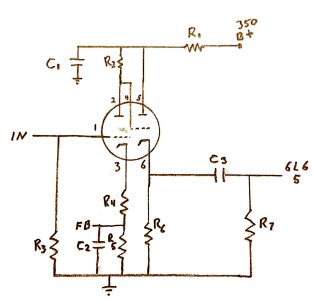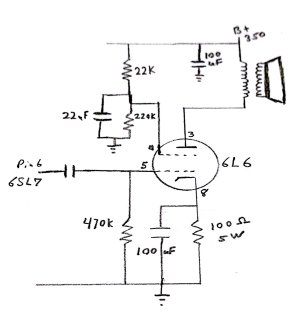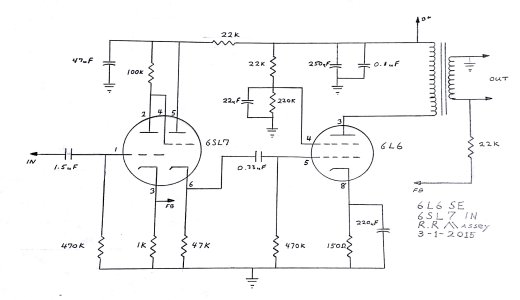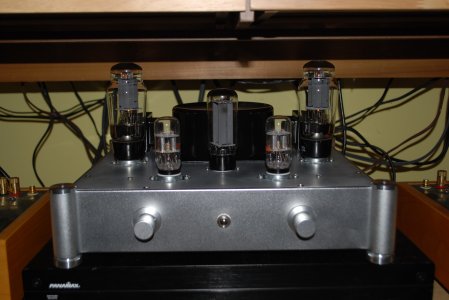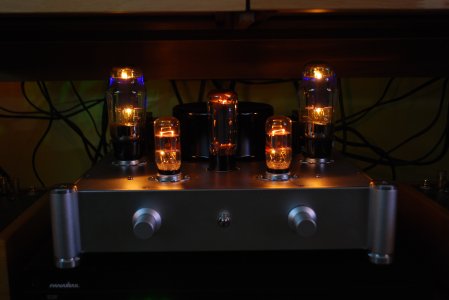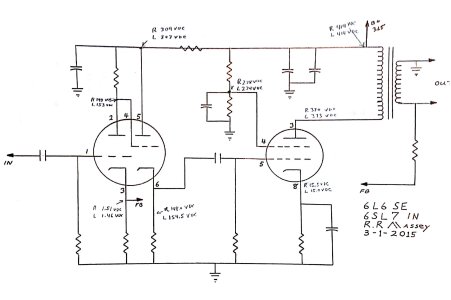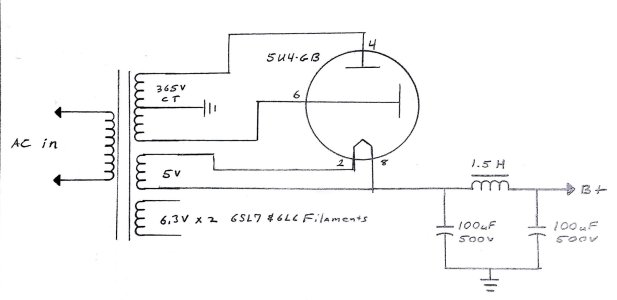randy@matrixq.com
New member
I've decided to completely rebuild an amp I had purchased before my adventures with Bottlehead. After building 6 BH kits and buying (and examining) a few others I became disenchanted with the way this one was put together. It is a home-built 6SL7/6L6 with a 5U4GB rectifier.
While it was all point-to-point wired, it was done so with no terminal strips, leaving webs of resistor and capacitor leads hanging in the air. Also, many of the components seemed under-rated which was evident when one of the capacitors blew in spectacular fashion.
One thing led to another until I finally decided to rebuild on a whole new chassis. The only things salvaged from the old build were the power transformer, the output transformers and the schematic.
So, before I commit to major portions of the build, I would like to run the different parts of the schematic by anyone who is interested to make sure I understand the purpose of each component. I have a good understanding of basic electronics and I've been making a study of Morgan Jones' "Valve Amplifiers", fourth edition. Still, questions remain.
Here is the input schematic through the 6SL7. When I purchased the amp, I was told that a 6SL7 or 6SN7 would work without modification. I've only used 6SL7.
R1: I understand this to be a voltage dropping resistor used to set the proper voltage on the anodes. It is 22K in the schematic but no indication of what the proper wattage should be.
R2: I understand this to further drop the voltage to the anode in the first stage. It also appears to be doing double-duty in setting the grid voltage for the second stage. It is 100K in the schematic.
C1: This cap is 47uF in the schematic and I assume it provides further filtration of the B+ on this side of R1.
R3: 470K, I'm guessing here, but I would say it sets the input impedance and provides voltage differential for the input.
C2, R4, R5: This part of the schematic differs from others I've seen online. Many schematics I see simply use R4, a 1K to ground and have the feedback come in on the other side directly to pin 3. C2 is 47uF and R5 is 300 ohms. Is this some kind of filter? This combination would roll off around 11 hz.
R6: Assuming same job as R4 in setting the voltage on the cathode. Just for the second stage instead of the first. 47K here.
C3, R7: Coupling capacitor to next stage. I've seen this vary from schematic to schematic. Mine shows 022uF, another shows 1.0uF. I have a nice Mundorf that is .33uF that I was considering. R7 seems to be ding what R3 did in the previous stage.
OK, that's my knowledge of tube amps so far, at least until I do some more reading. I'm curious to hear any comments and/or suggestions. I'm in no big hurry to finish the build. Rather do things right and want to know why I'm doing it.
thanks,
While it was all point-to-point wired, it was done so with no terminal strips, leaving webs of resistor and capacitor leads hanging in the air. Also, many of the components seemed under-rated which was evident when one of the capacitors blew in spectacular fashion.
One thing led to another until I finally decided to rebuild on a whole new chassis. The only things salvaged from the old build were the power transformer, the output transformers and the schematic.
So, before I commit to major portions of the build, I would like to run the different parts of the schematic by anyone who is interested to make sure I understand the purpose of each component. I have a good understanding of basic electronics and I've been making a study of Morgan Jones' "Valve Amplifiers", fourth edition. Still, questions remain.
Here is the input schematic through the 6SL7. When I purchased the amp, I was told that a 6SL7 or 6SN7 would work without modification. I've only used 6SL7.
R1: I understand this to be a voltage dropping resistor used to set the proper voltage on the anodes. It is 22K in the schematic but no indication of what the proper wattage should be.
R2: I understand this to further drop the voltage to the anode in the first stage. It also appears to be doing double-duty in setting the grid voltage for the second stage. It is 100K in the schematic.
C1: This cap is 47uF in the schematic and I assume it provides further filtration of the B+ on this side of R1.
R3: 470K, I'm guessing here, but I would say it sets the input impedance and provides voltage differential for the input.
C2, R4, R5: This part of the schematic differs from others I've seen online. Many schematics I see simply use R4, a 1K to ground and have the feedback come in on the other side directly to pin 3. C2 is 47uF and R5 is 300 ohms. Is this some kind of filter? This combination would roll off around 11 hz.
R6: Assuming same job as R4 in setting the voltage on the cathode. Just for the second stage instead of the first. 47K here.
C3, R7: Coupling capacitor to next stage. I've seen this vary from schematic to schematic. Mine shows 022uF, another shows 1.0uF. I have a nice Mundorf that is .33uF that I was considering. R7 seems to be ding what R3 did in the previous stage.
OK, that's my knowledge of tube amps so far, at least until I do some more reading. I'm curious to hear any comments and/or suggestions. I'm in no big hurry to finish the build. Rather do things right and want to know why I'm doing it.
thanks,

